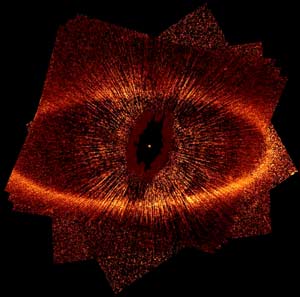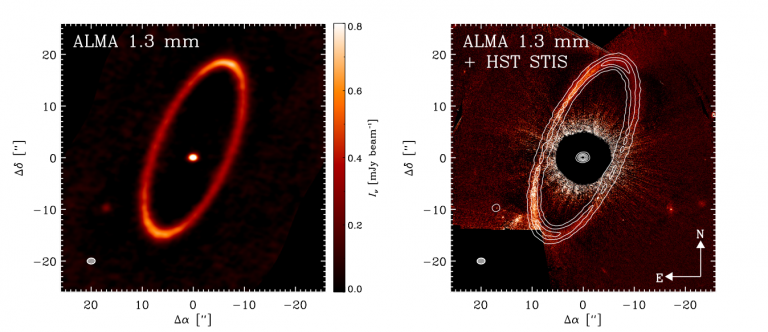Jun 26, 2017
Mara Zimmerman
Title: A Complete ALMA Map of the Fomalhaut Debris Disk
Click to access 1705.05867.pdf
Authors: Meredith Macgregor, Luca Matrá, Paul Kalas, et al.
Lead Author’s Institution: Harvard-Smithsonian Center for Astrophysics, 60 Garden Street, Cambridge, MA 02138, USA

Status: Accepted to ApJ [open access]
_________________________________________________________________________
The Fomalhaut debris disk is one of the most recognizable circumstellar disks—mainly because images of it bear an uncanny resemblance to a certain tyrant of Middle Earth.

An image of the debris disk, showing optical detection of dust (Source: Kalas et al. 2005).
The Fomalhaut system contains a dusty-debris disk, which gives the images their distinctive glowing eye appearance. Because of its proximity and unusual features, this debris disk is quite well studied, but, as the authors of this paper demonstrate, there is still much more we can learn from Fomalhaut. It has been shown to have a companion, Fomalhaut b, on a highly eccentric orbit. The interaction between Fomalhaut b and the debris disk is what makes this system so intriguing; when Fomalhaut b was first discovered, it was thought to be a massive planet, however new observations in today’s paper cast doubt on this hypothesis. Given Fomalhaut b’s lack of brightness in the optical and unusual brightness in the infrared, the authors of this paper suggest that Fomalhaut b is likely a giant dust cloud.
In this paper, the authors use observations from the ALMA (Atacama Large Millimeter/submillimeter Array) observatory to reveal the structure of the Fomalhaut disk, and observe an unusual glow in the disk corresponding to the apocenter of the system.


Figure 2: These ALMA images of Fomalhaut show the apocenter glow. The difference in brightness between the North-west (apocenter) and South-east (pericenter) sides reflects the surface density distribution of the disk. The image on the left is just the ALMA image while the image on the right is corrected by the HST images. On the right, the apocenter glow is clearly visible.
See the full article here .
Please help promote STEM in your local schools.
What do we do?
Astrobites is a daily astrophysical literature journal written by graduate students in astronomy. Our goal is to present one interesting paper per day in a brief format that is accessible to undergraduate students in the physical sciences who are interested in active research.
Why read Astrobites?
Reading a technical paper from an unfamiliar subfield is intimidating. It may not be obvious how the techniques used by the researchers really work or what role the new research plays in answering the bigger questions motivating that field, not to mention the obscure jargon! For most people, it takes years for scientific papers to become meaningful.
Our goal is to solve this problem, one paper at a time. In 5 minutes a day reading Astrobites, you should not only learn about one interesting piece of current work, but also get a peek at the broader picture of research in a new area of astronomy.
